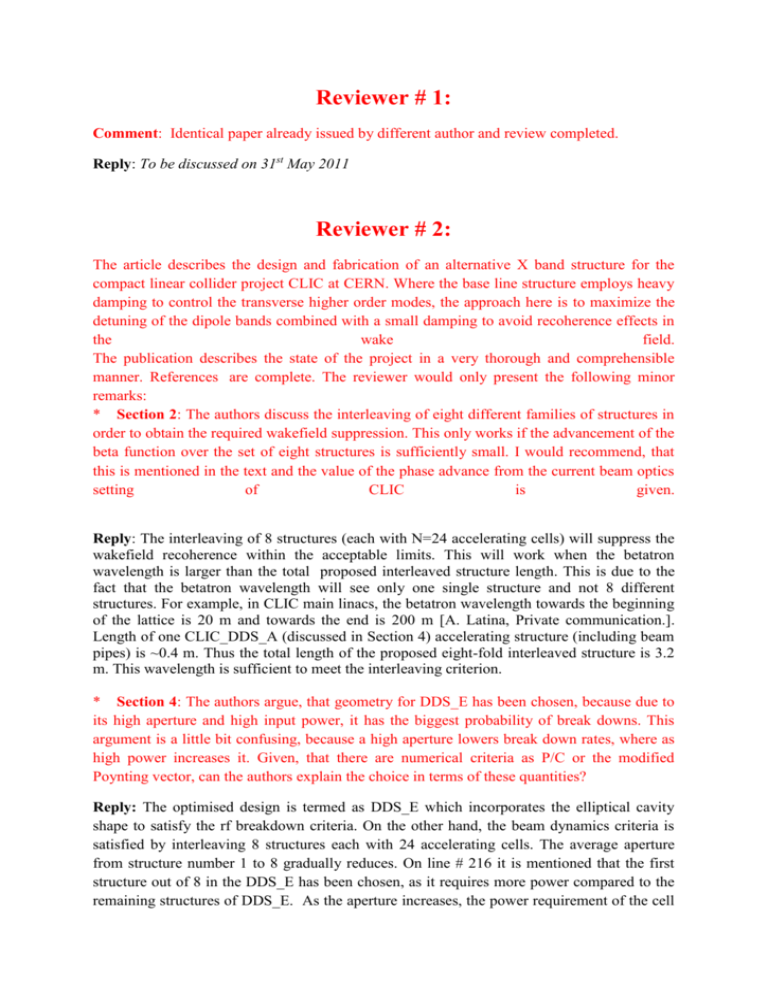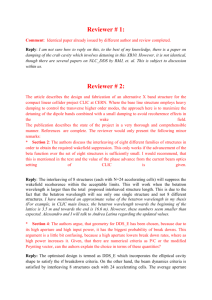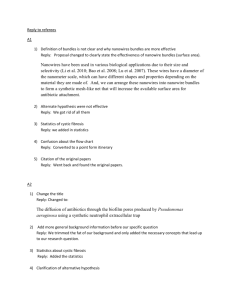ReplyToReviewers_30May - University of Manchester
advertisement

Reviewer # 1: Comment: Identical paper already issued by different author and review completed. Reply: To be discussed on 31st May 2011 Reviewer # 2: The article describes the design and fabrication of an alternative X band structure for the compact linear collider project CLIC at CERN. Where the base line structure employs heavy damping to control the transverse higher order modes, the approach here is to maximize the detuning of the dipole bands combined with a small damping to avoid recoherence effects in the wake field. The publication describes the state of the project in a very thorough and comprehensible manner. References are complete. The reviewer would only present the following minor remarks: * Section 2: The authors discuss the interleaving of eight different families of structures in order to obtain the required wakefield suppression. This only works if the advancement of the beta function over the set of eight structures is sufficiently small. I would recommend, that this is mentioned in the text and the value of the phase advance from the current beam optics setting of CLIC is given. Reply: The interleaving of 8 structures (each with N=24 accelerating cells) will suppress the wakefield recoherence within the acceptable limits. This will work when the betatron wavelength is larger than the total proposed interleaved structure length. This is due to the fact that the betatron wavelength will see only one single structure and not 8 different structures. For example, in CLIC main linacs, the betatron wavelength towards the beginning of the lattice is 20 m and towards the end is 200 m [A. Latina, Private communication.]. Length of one CLIC_DDS_A (discussed in Section 4) accelerating structure (including beam pipes) is ~0.4 m. Thus the total length of the proposed eight-fold interleaved structure is 3.2 m. This wavelength is sufficient to meet the interleaving criterion. * Section 4: The authors argue, that geometry for DDS_E has been chosen, because due to its high aperture and high input power, it has the biggest probability of break downs. This argument is a little bit confusing, because a high aperture lowers break down rates, where as high power increases it. Given, that there are numerical criteria as P/C or the modified Poynting vector, can the authors explain the choice in terms of these quantities? Reply: The optimised design is termed as DDS_E which incorporates the elliptical cavity shape to satisfy the rf breakdown criteria. On the other hand, the beam dynamics criteria is satisfied by interleaving 8 structures each with 24 accelerating cells. The average aperture from structure number 1 to 8 gradually reduces. On line # 216 it is mentioned that the first structure out of 8 in the DDS_E has been chosen, as it requires more power compared to the remaining structures of DDS_E. As the aperture increases, the power requirement of the cell or structure also increases, hence the ratio P/C does not change much, and this in general leads to excessive power flow on the cavity walls, which potentially increases the breakdown events. If the design of the cavity is such that increasing the aperture does not require more input power (i.e. shunt impedance does not change) then P/C ratio will improve. * Reference 11, typo: replace 'new Journal of Physics' by 'New Journal of Physics' Reply: Change made accordingly. Reviewer # 3: The paper has some very interesting results and should eventually be published. However the paper is rather disordered and poorly written. This paper needs to be clearer before publication. Comments on the Page 1 - CLIC frequency 11.9942 GHz not 12 GHz Reply: Page Change 2 - need some manuscript are: made discussion of cell accordingly. geometry and dimensions Reply: Changes made accordingly, page 2 - line 59 to 64. Page 2- line 74 structure no structure Reply: Change made accordingly. Page 3 - line 86 - why do you need to alter the iris thickness to maintain a low group velocity, I assume you are you changing some other parameter at the same time (such as iris radii) and this should be stated in this sentence. Reply: Changes made accordingly, page 3- line 90 to 93. Line 88 need a figure showing geometry to accompany table. Reply: Change made accordingly. Line 88 what phase advance is this structure? Why was this phase advance chosen. Reply: Phase advance for CLIC is mentioned on line # 14. This phase advance was chosen because it has maximum shunt impedance [R. Miller, LINAC’86]. Line 95 - This sentence doesn't make sense "are calculated using computational tool (uncoupled mode)," Reply: Change made accordingly Line 107 What is a non-smooth kick factor? Reply: In Fig. 9 the circuit model kick factors as a function of frequency in the frequency range of 15.5 to 16.5 GHz are functionally non-smoth. Page 111 what is the beam dynamics requirements for damping? How is this requirement obtained? Reply: The beam dynamics requirement is to suppress the wakefield below 6.6 V/pC/mm/m for a beam charge of 3.72x109 particles per bunch [4-5]. This is referred from [4-5] and CLIC beam dynamics group at CERN. Line 112 - In what way are the electrical requirements not met? How are these requirements calculated? Reply: Change made accordingly: The electrical breakdown requirement (Esur < 260 MV/m) is referred from [4-5] and are numerically calculated based on various experimental results of NLC and CTF2(3). In this structure the surface electric field was excessively large (Esur/Eacc= 5). Line 114 What is the CLIC-G structure, please reference this. Reply: Change made Line 121 Needs a reference for zero crossing accordingly: Reference Reply: Change made accordingly: Reference Line 153 and 162 Equation format has been corrupted in conversion to pdf [4-5]. [7,18-19] Reply: Change made accordingly (please refer the pdf version). Line 157 These are the first three dipole passband NOT modes. Modes are short for the eigenmodes of the structure and there are far more than three. Reply: Change made accordingly. Line 157 Is the first three passband sufficient? What about higher passbands? The 5th dipole passband can often have high shunt impedances in some structures? Reply: For travelling wave accelerating structures operating at 2π/3 phase advance per cell, it is observed [SLAC-PUB-9467] that the lowest dipole band has the largest kick factor, the other, not so large however, significant kicks belong to the third and the sixth dipole band. Hence we consider detuning and damping of the lowest dipole mode. Line 171 - How is this requirement calculated? Reply: Explained on page 4- line # 119 to 120. Line 212 This section requires an extensive discussion on the Q factors achievable in this structure. The manifold optimisation is related to the surface fields in the cavity and the HOM Q's so they cannot be decoupled. Changes made accordingly. However, the dipole mode Qs obtained in CLIC_DDS study are of the order of ~1000. The limitation in achieving further damped structure can be viewed as follows. The manifold tip cuts into the cavity to sample the dipole field, the dipole energy travels through the manifold before being damped in the remotely located loads (SiC). The coupling of the dipole modes to the manifolds, can in principle be increased to further reduce the Q. This can be achieved by increasing the width of the manifold coupling slot or by extending the penetration of the manifold tip further down the cavity. Both the approaches will exacerbate the surface fields. Hence, lowering the dipole Q is constrained by the limit on the acceptable surface fields [4-5]. Line 215 What do you mean by HOM couplers? The manifold is a HOM coupler, do you omit that? I am a bit lost about what you are and are not simulating. The discussion of the Q factors of the dipole modes should be in the section on structure optimisation and NOT in the high power testing chapter. Reply: The manifold couples out the field from the cavity. The HOM coupler will couple out the field from manifold to the damping loads. There is only one section (i.e section 4 starting from line 225) describing both, the structure optimisation and high power testing, because it is optimisation of a structure for high power testing. Line 229 How is the spectral functioned calculated? How are the modes damped at the end of the manifolds (absorbing boundary, HOM loads)? Reply: The calculation and theory of Spectral function is referred from [6,9-11]. The purpose of CLIC_DDS_A is to study the high power performance of the structure. In this structure no attempt has been made to damp the HOM in the manifolds. However, CLIC_DDS_B will serve this purpose and is being studied. Line 230 You only have the Q factors for the first dipole passband? What about the other passbands? Does this structure meet the Q requirements for all dipole modes in all dipole passbands? Reply: Please refer to line 168 - 169. Line 263 The conclusion/ final remarks is far too short. A single sentence is far from adequate. Reply: Change made accordingly.








